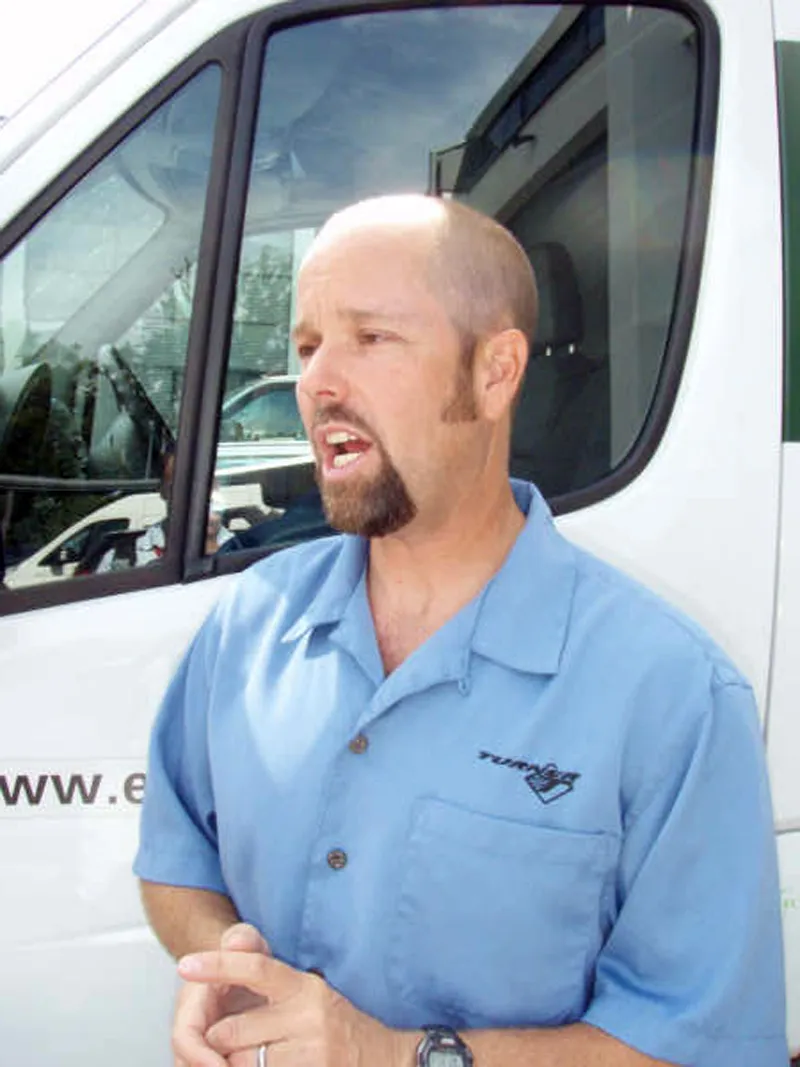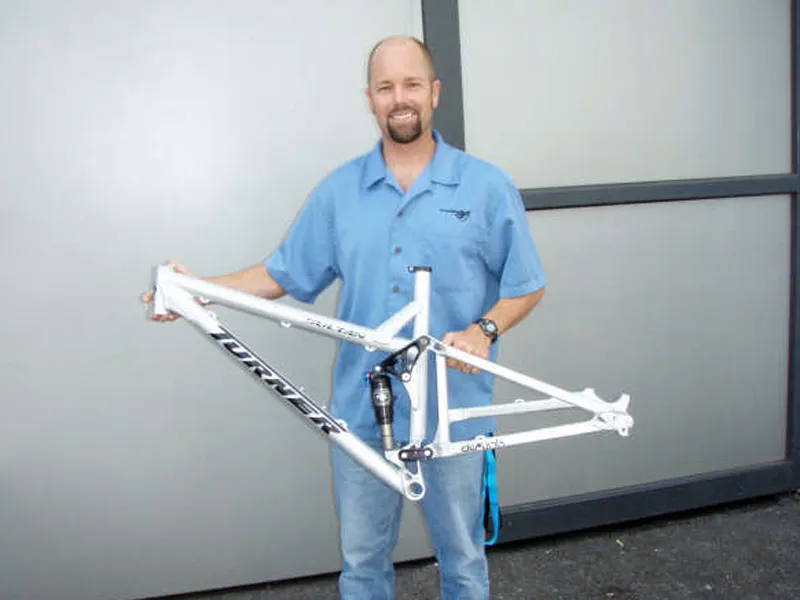For 2009 popular suspension mountain bike builder Dave Turner is about to unveil a new range using the dw-link mechanism in place of his previousTorque Neutralizing Technology(TNT) design. He tells us why he chose the new layout, his constant search for the perfect ride, the importance of customer feedback and his belief in US handmade bikes.
This is a tale of two Daves, suspension bike builder Turner and designer Weagle. When Dave Turner heard that dw-link inventor Dave Weagle had a new suspension system, the Split Pivot, that would work well with his existing suspension design, Turner was keen to talk to Weagle about licensing it.
Weagle says that Split Pivot is a “concentric dropout pivot linkage suspension system. The Split Pivot is not intended as replacement for or competitor to my dw-link system, but it is a lower manufacturing cost method of achieving suspension reactions superior to a single pivot bike.”
But Weagle feels that dw-link is the superior design, and he managed to convince Turner.
“When we talked about it he made it very clear that the ultimate in pedalling and braking anti-squat was with dw-link,” says Turner.
“Those conversations led to working with him to develop a dw-link version of my line for 2009. Since I was going to make the commitment to a new technology, I wanted only the best to integrate with Turner Bikes.”
The dw-link has been used to devastating effect on Sam Hill’s Iron House downhill bike as well as garnering industry plaudits on Ibis and Pivot trail bikes. Those are scenes that Turner has been closely involved with, so does he think there’s an optimum travel for an all-round trail bike?.
“There is no ‘best’ amount of travel as that is a matter of perspective,” he says.
“Certainly trail riders in Southern England do not have the ‘best’ travel for riding in the Lake District. I ride a [five inch travel] 5 Spot almost all the time, but I travel to areas that would certainly be better suited to another model.
“If there truly was one best all around bike it would be a lot easier to keep a single model in stock, especially if there was one ‘best’ colour!”

The man of the moment, Dave Turner
Tradition and longevity – the carbon question
Although he is happy to embrace new suspension designs, Turner is less keen to move away from traditional frame materials and fabrication, viewing carbon in particular with some reluctance.
“To start with,” he says, “it’s a question of pride in US craftsmanship and of supporting your own economy. The truth about carbon bike manufacturing is that it is almost entirely done in China or Taiwan and that is not somewhere I care to take my business at this time. I want to keep making what I can in the United States for as long as I can.
“It isn’t that I think offshore work is bad, but I think that Americans still produce the best frames. I also want to keep my ‘neighbours’ working and I am willing to pay more for products that I can put the U.S. flag on.”
It’s also about aesthetics and longevity. “I know that many buyers want a swoopy moulded frame, but I prefer a decidedly industrial look to the equipment that I design and sell,” he says.
“Surely not what the trends are, but that is the point. I am not trying to make trendy ‘styles,’ but to appeal to the rider looking for an off road tool to use for years that will also look good with last year’s black, today’s white, or tomorrow’s neon coloured components!”
Handmade bikes and customer satisfaction
A key player in the North American handmade bike industry, Turner is passionate about what handmade bikes can offer the consumer, as an alternative to the bikes made by bigger companies.
“Just as there is no ‘best’ travel for a trail bike, there is no ‘best’ brand,” he says. “I know that big companies act like Big Brother pushing their brands in every single avenue possible, but many people can handle choices.
“Customer choices in the bike they ride can reflect their way of thinking, so having small bike companies offers riders the freedom to think about the bike and what it offers them.
“We are not just another price point product on a dealer’s floor with house brand parts and an upgraded rear mech. Our customers really think about the difference between Turner Bikes and the other choices out there.”
His dedication to his customers is as well-known as their dedication to him and his bikes. He is proud of Turner Bikes’ after sales and servicing department which he has built on the belief that they should offer a “service that anyone would be happy to receive.”
Customer feedback is also what inspires him to try and design and sell the best line of bikes that he can. “I talk to a lot of our customers and I know they have done their homework, and not just listened to the local shop trying to sell them whatever they have in stock,” he says.
“After buying and riding multiple brands before they buy a Turner, our riders have come to understand what kind of rider they are and what they want from their next bike. Having a direct connection with Turner riders is what I believe makes a difference in every new design I do and I think that is also what makes a difference in every Turner Bike’s ride quality.”
The Turner story
To understand Turner’s fanaticism you have to go back through his history in mountain bikes, which goes to the earliest days of suspension bikes.
His first foray into mountain biking was to increase his fitness for skiing in the early 1980s.
“I was living in Colorado and the town went bike crazy every summer, but in those days it was road bikes,” he says. “I wanted to be a stronger skier and the few mountain bikes around looked like a lot of fun.”
Turner was an early believer in mountain bike suspension, becoming one of the first RockShox testers while racing professionally between 1987 and 1991. As the pro field riders got faster, he decided that he should move sideways and started looking for industry opportunities where he could be at the forefront of suspension design.
“I believed that rear suspension would be developed to complement the front, so I worked as a liaison between Mongoose and AMP Research and was a test rider for the early collaboration between them.”
AMP Research, headed by Horst Leitner, produced a series of ground-breaking suspension bikes featuring pivots on the chainstays, just in front of the dropouts. The patent for the ‘Horst link’ is now held by Specialized.
Turner worked at AMP Research for Leitner, with fellow mountain biking legend Karl Heinz Nicolai. Although a fantastic learning ground, it led to some mixed emotions for Turner.
“Actually it was frustrating much of the time,” he says. “I was a head strong washed up athlete trying to fit in at a company led by the powerful personality of Horst Leitner.
“I knew what a mountain bike should handle like, and I was not happy with the way those bikes rode. I spent my time in the fabrication shop which was a good experience. My memory of Karl was as a draftsman for Horst, we did a few rides together and a few beers. But as an intern, Horst worked with him more directly than the rest of us.
“After a time, I wanted the freedom to do my own designs and that is how I landed here.”
Turner Bikes, the company he started in order to execute his take on the application of the Horst Link four-bar suspension design, has garnered many podiums, customer devotion and magazine praise over the years, from his early Turner Burners to the Flux and 5 Spot. But by 2005 he was ready for another change.
Saying goodbye to the Horst Link
“I moved away from the ICT/ Horst link licenses in 2005, and from a performance standpoint I have no regrets,” says Turner.
His replacement, the TNT suspension design, has also been well received by the press and by customers.
Turner believes that this is because “the TNT bikes have worked just as well, and I learned more about brake squat and pedalling dynamics and what is applicable on the trail from that change.”
That design change wasn’t just a matter of moving a couple of pivots and shipping the result. Turner made sure his riders were happy before making the change.
“We had six prototype TNT rears that were swapped between customers for a few months in 2005,” he says. “Those rear ends were geometrically identical to the Horst Link versions that customers already had on their bikes. Everyone that had a chance to compare the TNT rears on their own bikes, on their regular trails with all their components later bought a production TNT rear as the overall ride impressed them enough to buy another rear triangle.”
The greatest Turner product
I was keen to find out what Turner product has made him the happiest. Surprisingly, his reply was not your standard industry sales pitch - even given the opportunity to push his 2009 bikes on the eve of the big trade shows.
“I'll be away at Eurobike for a week then on to Interbike and I will really miss my three kids,” he says. “I try my best to hang out with them as much as I can, as time goes so fast. I am taking them surfing this morning. We sat for hours last evening watching some videos and finished off some ice cream and cake. In the end, quality time with my kids is by far the most important work I will ever accomplish.”
More on 2009 Turner Bikes
The new 2009 line-up is released today on Turner Bikes’ website: www.turnerbikes.com
BikeRadar will bring you photos of the new bikes from the trade shows, and we'll be trying to get some ride time to confirm whether the new bikes live up to the bar set by his previous incarnations.



